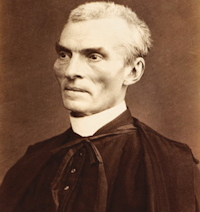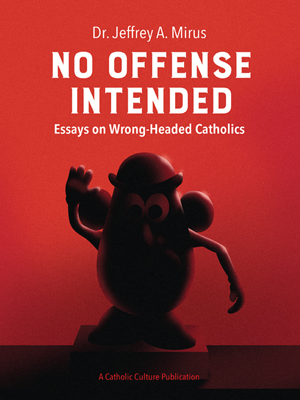Ordinary Time: August 2nd
Optional Memorial of St. Eusebius of Vercelli, bishop and Optional Memorial of Saint Peter Julian Eymard, priest
Other Commemorations: St. Stephen I, Pope and Martyr (RM); Our Lady of the Angels (Hist); St. Giustino Russolillo, Priest (RM)
» Enjoy our Liturgical Seasons series of e-books!
Born in La Mure, France, Saint Peter became a parish priest in 1834 and joined the Marists five years later. He fostered Eucharistic adoration throughout his life and founded a religious order of priest-adorers of the Holy Eucharist who came to be known as the Priests of the Blessed Sacrament.
St. Eusebius was a Roman priest of the fourth century. According to the acts relating his martyrdom he was condemned by Constantius, the Arian Emperor, to be starved to death in a room in his own house. He was buried in the cemetery of St. Calixtus. His cult has always enjoyed special favor in Rome and his house was transformed into a church.
According to the 1962 Missal of Bl. John XXIII the Extraordinary Form of the Roman Rite, today is the feast of St. Alphonsus de Liguori. His feast in the Ordinary Form of the Roman Rite is now celebrated on August 1. It is also the commemoration of St. Stephen I, a Roman, who ruled the Church from 254 to 257 during the reign of the Emperor Valerian. He is famous for his correspondence with St. Cyprian about the validity of baptism administered by heretics. The pope's martyrdom was the beginning of Valerian's persecution.
St. Eusebius of Vercelli
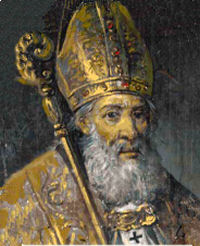 Eusebius was the founder of the Canons Regular, priests living under a religious rule and dedicated to pastoral work. The Canons Regular was the immediate result of the rise of monasticism in the East, and St. Eusebius of Vercelli saw the possibilities of this new movement for the clergy. His example was imitated all over the West and brought about a renewal of clerical life. He was born in Sardinia and as a child was taken to Rome, where he became a member of the Roman clergy under Pope Julius. Consecrated for the see of Vercelli in 344, he gathered his clergy into a community life, founding also the dioceses of Turin and Embrun. In 355, he attended the Council of Milan as legate of Pope Liberius, which defended St. Athanasius against those Western bishops intimidated by the emperor. When Eusebius was ordered along with other bishops to condemn Athanasius, he refused, insisting instead that they all sign the Nicene Creed. When threatened by the emperor, Eusebius stood his ground and told the emperor he had no right interfering in Church matters.
Eusebius was the founder of the Canons Regular, priests living under a religious rule and dedicated to pastoral work. The Canons Regular was the immediate result of the rise of monasticism in the East, and St. Eusebius of Vercelli saw the possibilities of this new movement for the clergy. His example was imitated all over the West and brought about a renewal of clerical life. He was born in Sardinia and as a child was taken to Rome, where he became a member of the Roman clergy under Pope Julius. Consecrated for the see of Vercelli in 344, he gathered his clergy into a community life, founding also the dioceses of Turin and Embrun. In 355, he attended the Council of Milan as legate of Pope Liberius, which defended St. Athanasius against those Western bishops intimidated by the emperor. When Eusebius was ordered along with other bishops to condemn Athanasius, he refused, insisting instead that they all sign the Nicene Creed. When threatened by the emperor, Eusebius stood his ground and told the emperor he had no right interfering in Church matters.
In anger, the emperor sent Eusebius into exile in Palestine, where he was severely mistreated by the Arians. He was moved around from place to place and after his release by the Emperor Julian he consulted with Athanasius in Alexandria on the Arian crisis. Returning to Italy, he joined with St. Hilary of Poitiers in opposing the Arian bishop of Milan and returned to Vercelli amid the rejoicing of his people.
Eusebius is considered by many to be the author of the Athanasian Creed, and a copy of the Gospels written in his own hand is preserved in the cathedral at Vercelli. He died on August 1, 371, his courage in suffering for the faith inspiring other bishops to oppose the Arian heresy.
—Excerpted from the The One Year Book of Saints by Rev. Clifford Stevens
Highlights and Things to Do:
- Read more about St. Eusebius:
- See the statue of St. Eusebius on the St. Peter's Basilica Colonnade.
- Read Pope Benedict XVI's General Audience on St. Eusebius.
- St. Eusebius of Vercelli refused to "go along with the crowd," even when threatened by an emperor, and he suffered long and cruelly for his convictions. Sometimes we have to oppose others, especially in matters that are important, and how we do it is as important as that we do it. We should never lose our Christian kindness and gentle manner, even in opposing others, but it should be very clear where we stand.
- Arianism was a Christological view held by followers of Arius in the early Christian Church. They denied that Christ and God the Father were of the same fundamental essence, seeing the Son as a created and inferior being to the Father. (See Hilaire Belloc's chapter on Arianism from The Great Heresies.) Read what the The Catholic Encyclopedia says about this heresy. Say the Apostles Creed or an Act of Faith and thank God for the gift of the true Faith.
- The Christology of Jehovah's Witnesses is also a form of Arianism; they regard Arius as a forerunner of Charles Taze Russell, the founder of their movement. Imitate St. Eusebius by learning how to defend your faith. Read these articles from the Catholic Culture Library:
St. Peter Julian Eymard
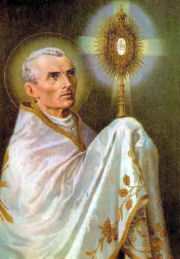 Born in La Mure d'Isere in southeastern France, Peter Julian's faith journey drew him from being a priest in the Diocese of Grenoble (1834) to joining the Marists (1839) to founding the Congregation of the Blessed Sacrament (1856). In addition to those changes, Peter Julian coped with poverty, his father's initial opposition to Peter's vocation, serious illness, a Jansenistic striving for inner perfection and the difficulties of getting diocesan and later papal approval for his new religious community.
Born in La Mure d'Isere in southeastern France, Peter Julian's faith journey drew him from being a priest in the Diocese of Grenoble (1834) to joining the Marists (1839) to founding the Congregation of the Blessed Sacrament (1856). In addition to those changes, Peter Julian coped with poverty, his father's initial opposition to Peter's vocation, serious illness, a Jansenistic striving for inner perfection and the difficulties of getting diocesan and later papal approval for his new religious community.
His years as a Marist, including service as a provincial leader, saw the deepening of his Eucharistic devotion, especially through his preaching of Forty Hours in many parishes.
The Congregation of the Blessed Sacrament began working with children in Paris to prepare them to receive their first Communion. It also reached out to non-practicing Catholics, inviting them to repent and begin receiving Holy Communion again. He was a tireless proponent of frequent Holy Communion, an idea given more authoritative backing by Pope Pius X in 1905.
Inspired at first by the idea of reparation for indifference to the Eucharist, Peter Julian was eventually attracted to a more positive spirituality of Christ-centered love. Members of the men's community, which Peter founded, alternated between an active apostolic life and contemplating Jesus in the Eucharist. He and Marguerite Guillot founded the women's Congregation of the Servants of the Blessed Sacrament.
Peter Julian Eymard was beatified in 1925 and canonized in 1962, one day after Vatican II's first session ended.
—Excerpted from the Saint of the Day, Leonard Foley, O.F.M.
Symbols and Representation: Eucharist, Monstrance, Eucharistic Adoration, Eucharistic Congress, Cope, Humeral Veil, Congregation of the Blessed Sacrament, Servants of the Blessed Sacrament, Real Presence
Highlights and Things to Do:
- Make a holy hour today. You might find this writing — My Eucharistic Day — from the Catholic Culture Library helpful. It was compiled from the writings of Saint Peter Julian Eymard with the permission and encouragement of the Blessed Sacrament Fathers.
- From the Catholic Culture library: Audience with God in Your Parish
- Read more about St. Peter Julian Eymard:
- Find out more about the two religious institutes that St. Peter founded: Congregation of the Blessed Sacrament and Servants of the Blessed Sacrament.
- This site covers the World of St. Peter Julian Eymard.
- St. Peter's relics are located in Chapelle du Corpus-Christi (Corpus Christi Chapel, Eglise du Saint Sacrement) in Paris, France.
St. Stephen I
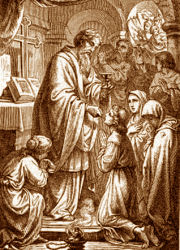 He is said to have been the chief deacon of Pope Lucius and recommended by him as his successor. He was soon involved in the case of two Spanish bishops who apparently had under persecution bought letters of safety from the persecutors. One of them, Martial, was deposed, and the other, Basilides, resigned, but then went to Rome and got the pope to reinstate him. He "imposed upon our colleague Stephen," declared the other Spanish bishops, "who lives a long way off and did not know the true facts of the case." St. Cyprian agreed that the two offenders were unfit to continue in office and the affair seems to have provoked a certain discord between him and Stephen, but what happened further is no longer known. Then Cyprian wrote to the pope in support of the bishops of Gaul, urging him to take action against the bishop of Arles, Marcian, who was accused of Novatianist rigorism but the result of this case is not on record either.
He is said to have been the chief deacon of Pope Lucius and recommended by him as his successor. He was soon involved in the case of two Spanish bishops who apparently had under persecution bought letters of safety from the persecutors. One of them, Martial, was deposed, and the other, Basilides, resigned, but then went to Rome and got the pope to reinstate him. He "imposed upon our colleague Stephen," declared the other Spanish bishops, "who lives a long way off and did not know the true facts of the case." St. Cyprian agreed that the two offenders were unfit to continue in office and the affair seems to have provoked a certain discord between him and Stephen, but what happened further is no longer known. Then Cyprian wrote to the pope in support of the bishops of Gaul, urging him to take action against the bishop of Arles, Marcian, who was accused of Novatianist rigorism but the result of this case is not on record either.
An important controversy then arose on the subject of baptism administered by heretics. St. Cyprian and three African synods declared that such baptism was null and void, and that one so baptized must be baptized anew upon becoming a Catholic; this innovation was supported by many bishops in Asia. St. Stephen faithfully upheld the ancient accepted teaching that, other things being equal, baptism given by heretics is valid, and was violently abused by Firmilian of Casarea in Cappadocia in consequence. "No innovation must be introduced," declared the pope, "but let that be observed which tradition has handed down," and refused to receive the delegates of the African synod that supported St. Cyprian in the year 256. Stephen thought of excommunicating the innovators, writes St. Augustine, "but, having the pity of holy charity, he judged it better to abide in union. The peace of Christ triumphed in their hearts," but the disagreement continued.
St. Stephen sent material succour to the faithful in the provinces of Syria and Arabia, and is said to have taken the first step in the emergence of liturgical vestments: the Liber Pontificalis states that he ordered that clothes worn by clerics at church services were to be kept for that purpose, and not taken into daily use or worn by laymen.
—Excerpted from the A Dictionary of the Popes, Donald Attwater
Highlights and Things To Do:
- Read more about St. Stephen I:
Our Lady of the Angels
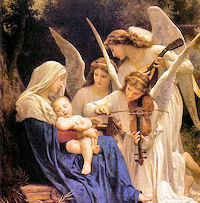 From the earliest days of the Church. Mary has held the title Our Lady Queen of Angels. At the Annunciation, at the Nativity, at her Assumption into heaven, and finally at her Coronation as Queen of Angels and Men, angels have been associated with Our Lady. There are a number of famous shrines dedicated to Mary under this title, including the Basilica of Santa Maria degli Angeli at Assisi, where the great St. Francis recognized his vocation; the church in Rome which was designed and executed by Michelangelo on ruins from the time of Diocletian; the shrine of St. Mary of the Angels in Engeberg, Switzerland; Notre Dame des Anges near Lurs, France; the shrine dedicated to Our Lady of Angels at Boulogne, France; the church of Our Lady of the Angels in London, England; and the Mission of Our Lady of the Angels in Los Angeles.
From the earliest days of the Church. Mary has held the title Our Lady Queen of Angels. At the Annunciation, at the Nativity, at her Assumption into heaven, and finally at her Coronation as Queen of Angels and Men, angels have been associated with Our Lady. There are a number of famous shrines dedicated to Mary under this title, including the Basilica of Santa Maria degli Angeli at Assisi, where the great St. Francis recognized his vocation; the church in Rome which was designed and executed by Michelangelo on ruins from the time of Diocletian; the shrine of St. Mary of the Angels in Engeberg, Switzerland; Notre Dame des Anges near Lurs, France; the shrine dedicated to Our Lady of Angels at Boulogne, France; the church of Our Lady of the Angels in London, England; and the Mission of Our Lady of the Angels in Los Angeles.
—Excerpted from A Litany of Mary by Ann Ball
August 2nd – Feast of Our Lady of the Angels (aka the Feast of the Portiuncula). The small chapel of St. Mary of the Angels (Our Lady of the Angels) was very dear to St. Francis of Assisi. He referred to it as the Portiucula (or the Little Portion) and it is considered the cradle of the Franciscan Order. In 1209, as the quarters of Rivo Torto became too small for the newly forming religious order, St. Francis obtained from the Benedictines the use of the Portiuncula, for which he paid a basket of fish. The church and the surrounding small parcel of land were is disrepair. Just as he did at San Damiano, St. Francis rebuilt it, adding small huts (cells) and enclosing it all in a protective hedge. It was there that St. Francis gained a more vivid understanding of his own vocation. He held the annual meetings of the friars (Chapters) there and it is where he desired to spend his final earthly moments; dying in his nearby cell October 3, 1226.
St. Francis felt that the Portiuncula was a place filled with God’s grace. In 1216, at the request of St. Francis, the Pope granted special privilege (plenary indulgence—a remission before God of the temporal punishment due to sins) to all those who would visit the little chapel.
Although limited to noon on August 1st to midnight on August 2nd, the privilege continues to be granted to this day; not only to those who visit the Portiuncula, but to anyone who visits any church where the friars live and minister. To receive this privilege (for yourself or for someone else—living or deceased), in addition to the visit, one must receive the Sacrament of Reconciliation within several weeks of the feast, go to Mass and receive the Eucharist, recite the Our Father and Apostles Creed, and pray for the intentions of the Holy Father.
The beautiful Basilica of Santa Maria degli Angeli that now surrounds the Portiuncula chapel was begun in 1569 (completed in 1684) by decree of Pius V. It was meant to accommodate the huge crowds of pilgrims who came on August 2nd for Il Perdono (Portiuncula Indulgence). This is an important feast day for all Franciscans and is celebrated in Franciscan churches throughout the world.
—Excerpted from Our Lady of Angels Province
Patronage: Bisenti, Italy; Cassano delle Murge, Italy; Costa Rica; diocese of Getafe, Spain
Highlights and Things to Do:
- See the site of the Basilica of Santa Maria degli Angeli which houses the Portiuncula.
- Visit the site of the Portiucula to see more images.
- For more information on Our Lady of Angels and the Portiuncula Indulgence, see:
- Franciscan University of Steubenville, Ohio, has an exact replica of the Portiuncula with Perpetual Adoration of the Blessed Sacrament offered throughout the academic year. In 2016 re-designated as a as an Indulgence Site.
St. Giustino Maria Russolillo
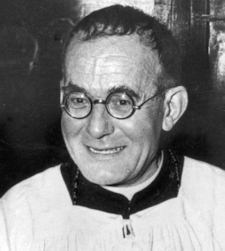 Fr. Justin Maria Russolillo, the Founder of the Society of Divine Vocations, was born in Pianura (Naples, Italy) on January 18, 1891. He was ordained a priest on September 20, 1913. No sooner he became the pastor of Pianura on September 20, 1920, than he began working for the realization of his dream. That same year, the first community of the Society of Divine Vocations, which became known as the “Vocationist Fathers” came into being. The Society of Divine Vocations received its first Diocesan approval on May 26, 1927. It became a Congregation of Pontifical right on May 24, 1947.
Fr. Justin Maria Russolillo, the Founder of the Society of Divine Vocations, was born in Pianura (Naples, Italy) on January 18, 1891. He was ordained a priest on September 20, 1913. No sooner he became the pastor of Pianura on September 20, 1920, than he began working for the realization of his dream. That same year, the first community of the Society of Divine Vocations, which became known as the “Vocationist Fathers” came into being. The Society of Divine Vocations received its first Diocesan approval on May 26, 1927. It became a Congregation of Pontifical right on May 24, 1947.
Fr. Justin established the Vocationist Fathers and their special charism to foster and promote vocations to the priesthood, religious life, and holiness among all God’s people. To carry on this vocational work Fr. Justin established the Vocationary, a special house of formation that would supply vocations to both religious order and diocesan seminaries.
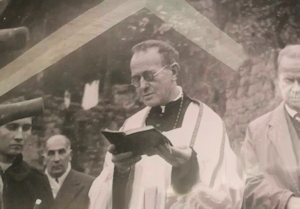 For those who are undecided whether they want to be a Vocationist, a Diocesan priest or a member of another religious community, the Vocationist Fathers offer the Vocationary, a place of vocational discernment. The Vocationary was established especially to attend to the needs of those financially unable to attend the seminary and those who are still searching and discerning their vocation. By establishing the Vocationary, Fr. Justin focused his attention not only on candidates seeking a religious or priestly vocation but also on those who had left the priesthood or who were in danger of doing so. Thus, the Vocationary has often given life to those who had abandoned the active ministry.
For those who are undecided whether they want to be a Vocationist, a Diocesan priest or a member of another religious community, the Vocationist Fathers offer the Vocationary, a place of vocational discernment. The Vocationary was established especially to attend to the needs of those financially unable to attend the seminary and those who are still searching and discerning their vocation. By establishing the Vocationary, Fr. Justin focused his attention not only on candidates seeking a religious or priestly vocation but also on those who had left the priesthood or who were in danger of doing so. Thus, the Vocationary has often given life to those who had abandoned the active ministry.
Fr. Justin died on August 2, 1955 at Vocationist Fathers' Motherhouse in Pianura.
On December 18, 1997 Pope John Paul II recognized Fr. Justin heroic virtues and proclaimed him a Venerable. On July 1, 2010 Pope Benedict XVI signed the decree of validity of the miracle by Fr. Justin intercession to Ida Meloro of East Hanover, New Jersey (USA). The ceremony of beatification was on May 7, 2011 in Pianura (Naples, Italy), the birthplace of Fr. Justin. He was canonized by Pope Francis on May 15, 2022.
The Vocationists’ spirituality stems from Fr. Justin’s conviction that all people are called to holiness. Their “first duty” is to be with God. Their ultimate goal is to achieve Divine Union. They are called to establish and live the relationship of “child, parent, and spouse” of God on the pattern of Jesus, Mary, and Joseph. The Catholic Church, the Holy Family, and the Blessed Trinity are the heart and center of their spirituality, which may be summarized thus: “Ascension to the Trinity with the Holy Family in the Church.”
—Excerpted from Society of Divine Vocations USA Quasi Province
Highlights and Things to Do:
- Read more about the Vocationists.
- Read this biography of St. Giustino Maria Russolillo.
- Learn more about St. Giustino:


